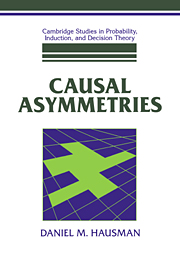Book contents
- Frontmatter
- Contents
- List of Figures
- Acknowledgments
- Introduction: Causation and its Asymmetries
- 1 Metaphysical Pictures and Wishes
- 1* Transfer Theories
- 2 Is Causation a Relation Among Events?
- 3 Causation, Regularities, and Time: Hume's Theory
- 4 Causation and Independence
- 4* Causation, Independence, and Causal Connection
- 5 Agency Theory
- 5* Causal Generalizations and Agency
- 6 The Counterfactual Theory
- 6* Independence and Counterfactual Dependence
- 7 Counterfactuals, Agency, and Independence
- 7* Agency, Counterfactuals, and Independence
- 8 Causation, Explanation, and Laws
- 8* Causation, Explanation, and Independent Alterability
- 9 Probabilistic Causation
- 10 Causation and Conditional Probabilities
- 10* Causal Graphs and Conditional Probabilistic Dependencies
- 11 Intervention, Robustness, and Probabilistic Dependence
- 11* Interventions and Conditional Probabilities
- 12 Operationalizing and Revising the Independence Theory
- 12* Probability Distributions and Causation
- 13 Complications and Conclusions
- Appendix A Alphabetical List of Propositions
- Appendix B List of Theorems
- References
- Index
12* - Probability Distributions and Causation
Published online by Cambridge University Press: 20 April 2010
- Frontmatter
- Contents
- List of Figures
- Acknowledgments
- Introduction: Causation and its Asymmetries
- 1 Metaphysical Pictures and Wishes
- 1* Transfer Theories
- 2 Is Causation a Relation Among Events?
- 3 Causation, Regularities, and Time: Hume's Theory
- 4 Causation and Independence
- 4* Causation, Independence, and Causal Connection
- 5 Agency Theory
- 5* Causal Generalizations and Agency
- 6 The Counterfactual Theory
- 6* Independence and Counterfactual Dependence
- 7 Counterfactuals, Agency, and Independence
- 7* Agency, Counterfactuals, and Independence
- 8 Causation, Explanation, and Laws
- 8* Causation, Explanation, and Independent Alterability
- 9 Probabilistic Causation
- 10 Causation and Conditional Probabilities
- 10* Causal Graphs and Conditional Probabilistic Dependencies
- 11 Intervention, Robustness, and Probabilistic Dependence
- 11* Interventions and Conditional Probabilities
- 12 Operationalizing and Revising the Independence Theory
- 12* Probability Distributions and Causation
- 13 Complications and Conclusions
- Appendix A Alphabetical List of Propositions
- Appendix B List of Theorems
- References
- Index
Summary
Causation and Causal Connection: A Graphical Exposition
The relations between causation and causal connection (and ultimately probabilistic dependencies) can be clarified with the help of the three kinds of graphs. Figure 12.3a, 12.3b, and 12.3c show respectively the normal, path, and connection graphs that correspond to the causal relations among the salt concentrations of the five salt basins in figure 6.3, which is reproduced in figure 12.3d. To each normal graph, there corresponds a single path graph, but a path graph may correspond to more than one normal graph. The connection principle implies that for each path graph, there is a unique connection graph: For all vertices u and v in a connection graph Gc, there is an undirected edge between u and v if and only if in a corresponding path graph Gp with the same vertices there is an edge from u to v or from v to u or there is an edge from some vertex to both u and v. If one substitutes the word “path” for the word edge, this same claim defines the unique connection graph corresponding to every normal graph.
If I (or Ig) is true, then there is a unique path graph corresponding to each connection graph that correctly represents the causal relations: For all vertices u and v in a path graph Gp, there is a directed edge from u to v if and only if in the corresponding connection graph Gc with the same vertices there is an undirected edge between u and v and for all vertices w other than v if there is an edge in Gc between w and u, then there is an edge between w…
- Type
- Chapter
- Information
- Causal Asymmetries , pp. 255 - 262Publisher: Cambridge University PressPrint publication year: 1998



